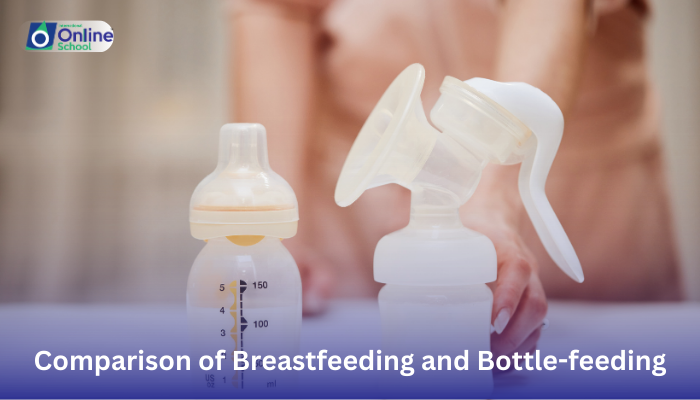
Learning Outcomes:
i. Identify the key advantages and disadvantages of breastfeeding compared to bottle-feeding.
ii. Analyze the nutritional, immunological, and developmental benefits of each feeding method.
iii. Understand the practical considerations and social factors influencing the choice between breastfeeding and bottle-feeding.
iv. Appreciate the importance of informed decision-making for parents regarding infant feeding.
Introduction:
For every new parent, the question arises: breastfeed or bottle-feed? This seemingly simple choice unfolds into a complex tapestry of factors, each whispering its own advantages and disadvantages. In this lesson, we'll explore the different threads in this tapestry, aiming to equip you with the knowledge to navigate the choices confidently.
i. Breastfeeding: Nature's Symphony of Nourishment
Breastfeeding is often described as the "gold standard" for infant feeding. Its benefits extend far beyond simply providing food:
Nutritional Advantages:
Perfectly balanced: Breast milk provides a unique composition of nutrients, proteins, and antibodies tailored to a baby's specific needs.
Digestive harmony: Breast milk is easily digestible, reducing the risk of colic and other digestive issues.
Immune booster: Breast milk is rich in antibodies, protecting babies from infections and illnesses.
Developmental Advantages:
Bonding and comfort: Breastfeeding promotes skin-to-skin contact, fostering closeness and emotional well-being between mother and child.
Oral development: Suckling on the breast strengthens facial muscles, aiding in speech and jaw development.
Cognitive boost: Studies suggest breastfeeding may be linked to improved cognitive development and academic performance.
However, breastfeeding also comes with challenges:
Time commitment: Breastfeeding is a demanding process, requiring frequent feedings and adjustments.
Physical discomfort: Engorgement, mastitis, and nipple soreness can be concerns for some mothers.
Social limitations: Public breastfeeding may face stigma in certain environments.
ii. Bottle-feeding: A Modern Approach to Nourishment
Formula-feeding with bottles offers another path for infant feeding. Its advantages include:
Practical Advantages:
Flexibility: Bottle-feeding allows for shared feeding responsibilities and easier travel.
Consistency: Formula provides a predictable and consistent nutritional intake.
Dietary control: Mothers with certain allergies or dietary restrictions may find formula a suitable option.
However, bottle-feeding also has its drawbacks:
Nutritional concerns: Formula lacks the unique immune-boosting properties and precise nutrient balance of breast milk.
Bonding limitations: Skin-to-skin contact and the hormonal symphony of breastfeeding may be missed.
Financial considerations: Formula and bottle-feeding supplies can be expensive compared to breastfeeding.
The Choice is Personal: Weaving a Decision Based on Your Needs
Ultimately, the choice between breastfeeding and bottle-feeding is a personal one, influenced by various factors:
Maternal health: Medical conditions and medication use might impact breastfeeding feasibility.
Lifestyle and support: Time constraints, cultural context, and access to support networks play a role.
Individual preferences: Some mothers simply find one method more comfortable or practical than the other.
There is no single "right" answer to the breastfeeding vs. bottle-feeding dilemma. Each family's journey is unique, woven with the threads of individual needs, priorities, and circumstances. By understanding the advantages and disadvantages of each method, coupled with open communication and informed decision-making, parents can confidently choose the path that best nourishes their little one, both physically and emotionally. Remember, the most important factor is providing a loving and nurturing environment for your baby to thrive, regardless of the chosen feeding method.